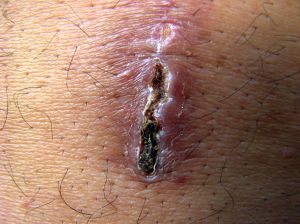A septic wound is an infected injury that can develop on any part of the body; it takes a longer time to heal than a normal wound. Any wound resulting from a cut, bite, burn, or lesion, can get infected when not treated well, hence becoming septic. Some common symptoms of septic wounds include, releasing of pus, excessive bleeding and constant inflammation. Some septic wounds on limbs can be a reason for amputation, in order to prevent further infection of the whole limb. Moreover, the pain, incapacitation and odor from a septic wound can cause great discomfort to the victim. It might not be convenient for one to see a doctor everyday to clean, treat and dress a septic wound; thus the need to know how to take care of it. Here is how to treat a septic wound.
How to clean a septic wound
If a wound is already infected, it is essential to make sure that the infection does not spread to the rest of the body because this can lead to infection of other vital body parts; hence endangering life. You need a wash cloth, cotton balls, 2 cups of warm water, salt and an antiseptic. Add about one teaspoon of table salt in the water and stir to dissolve, then wet the wash cloth with the salty water and wring excess water.
Use the wash cloth to clean around the septic wound, and if you have a scab forming on the wound, be careful not to remove it because this could deepen the wound. Clean any pus and blood, applying very little pressure on top of the scab to squeeze out accumulated pus. Salty water kills the microorganisms on the wound, and also keeps it dry. After thoroughly cleaning the wound, use a cotton ball to apply an antiseptic, like rubbing alcohol or hydrogen peroxide on top of the septic wound and allow for absorption.
How to dress a septic wound
If there were no pathogens floating around in the air, it would be preferable not to dress a septic wound to allow for aeration and faster healing. You also need to cover a septic wound so that blood and pus from the injury do not stain your clothing. To dress a septic wound you need a gauge cotton dresser, cotton and some antibiotic. Add a generous amount of liquid antibiotic on a cotton ball and place it on top of the septic wound, then loosely but securely wrap the cotton gauge dresser around it. Secure it with a dresser pin or two to three band aids.
Some precautionary measures when treating a septic wound
Change the dressing on the wound every day to avoid further infection of the wound. Over time the dressing collects bacteria that can infect and deepen the wound. Odor from the septic wound is a sign that it needs changing.
Visit a doctor or healthcare provider if you realize that a wound is taking longer that expected to heal.
Some septic wounds are symptoms of some conditions like diabetes, so visiting a doctor can help you combat the problem before it worsens. Some people have had their limbs amputated due to infection of minor wounds like scratches. Visiting a healthcare provider is also necessary so you can get better treatment for the wound.
Knowing how to treat a septic wound can save one a lot of money, and even speed up the healing process of the wound.




